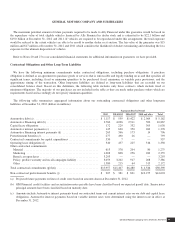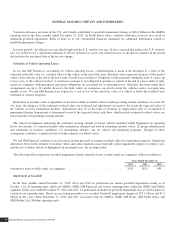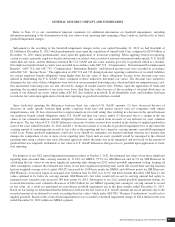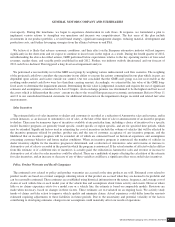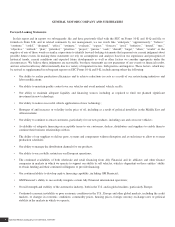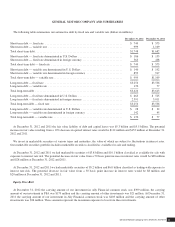General Motors 2012 Annual Report Download - page 60
Download and view the complete annual report
Please find page 60 of the 2012 General Motors annual report below. You can navigate through the pages in the report by either clicking on the pages listed below, or by using the keyword search tool below to find specific information within the annual report.
GENERAL MOTORS COMPANY AND SUBSIDIARIES
Valuation of Deferred Tax Assets
We evaluate the need for deferred tax asset valuation allowances based on a more likely than not standard. The ability to realize
deferred tax assets depends on the ability to generate sufficient taxable income within the carryback or carryforward periods provided
for in the tax law for each applicable tax jurisdiction. We consider the following possible sources of taxable income when assessing
the realization of deferred tax assets:
• Future reversals of existing taxable temporary differences;
• Future taxable income exclusive of reversing temporary differences and carryforwards;
• Taxable income in prior carryback years; and
• Tax-planning strategies.
The assessment regarding whether a valuation allowance is required or should be adjusted also considers all available positive and
negative evidence factors, including but not limited to:
• Nature, frequency, and severity of recent losses;
• Duration of statutory carryforward periods;
• Historical experience with tax attributes expiring unused; and
• Near- and medium-term financial outlook.
It is difficult to conclude a valuation allowance is not required when there is significant objective and verifiable negative evidence,
such as cumulative losses in recent years. We utilize a rolling three years of actual and current year anticipated results as the primary
measure of cumulative losses in recent years.
The evaluation of deferred tax assets requires judgment in assessing the likely future tax consequences of events that have been
recognized in our financial statements or tax returns and future profitability. Our accounting for deferred tax consequences represents
our best estimate of those future events. Changes in our current estimates, due to unanticipated events or otherwise, could have a
material effect on our financial condition and results of operations.
At December 31, 2012, as a result of sustained profitability in the U.S. and Canada evidenced by three years of earnings and the
completion of near- and medium-term business plans in the three months ended December 31, 2012 that forecast continuing
profitability, we determined it was more likely than not future earnings will be sufficient to realize deferred tax assets in these two
jurisdictions. Accordingly we reversed most of the U.S. and Canadian valuation allowances resulting in non-cash income tax benefits
of $33.2 billion and $3.1 billion. We retained valuation allowances of $2.3 billion against deferred tax assets in the U.S. and Canada
related primarily to capital loss tax attributes and state operating loss carryforwards which we continue to believe do not meet the
more likely than not threshold for releasing the valuation allowance. We retained additional valuation allowances of $8.7 billion
against non-U.S. deferred tax assets primarily related to GME and South Korea business units with losses.
At December 31, 2011, as a result of sustained profitability in Australia, we released the valuation allowance against deferred tax
assets. The reduction in the valuation allowance resulted in a non-cash income tax benefit of $0.5 billion.
If the remaining valuation allowance jurisdictions experience profitability in the future, utilization of tax attributes to offset taxable
income will reduce the overall level of deferred tax assets subject to valuation allowances. In the periods in which the valuation
allowances are released, we will record a tax benefit reflecting the release, which will reduce our effective tax rate.
General Motors Company 2012 ANNUAL REPORT 57








